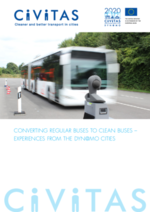Low emission public transport in Koprivnica
Summary
With the implementation of public transport with two converted e-buses, the city of Koprivnica has been spearheading the establishment of a model of efficient public transport systems and became an example for other small cities in the region. Innovative technology implementation is the basic part of the whole scheme because the use of electric buses has never been applied in Croatia before. The result is a reduction of CO2emissions by 20% in relation to the current bus fleet operation.
Implementing sustainable mobility
Public transport for smaller cities is not common in Croatia and is usually confined to connecting the outskirts to the central bus or railway station. In this aspect, Koprivnica has been spearheading the development and established a model of efficient public transport systems for a large number of communities of similar size. Furthermore, previous testing of public transport showed that the system of classic public transport was not applicable to small towns due to its low efficiency. Therefore, the testing of the new model inside the innovative corridor and establishment of new public-private-partnership PPP in the transport sector were equally innovative. Innovative technology implementation was the basic part of the whole scheme because the use of electric buses had never been applied in Croatia before. It has been completely innovative in the choice of technology, providing an opportunity for the study of benefits of electromobility in the context of a small city. Testing of the performance of electric vehicles, efficiency of batteries, issues of maintenance and storage, and evaluation of user satisfaction with the innovative service has provided relevant data for possible replication of this measure in the wider international region.
The main objectives of this measure were:
- Establishment of first public transport in the city of Koprivnica based on electric minibuses, and improved school and factory bus fleet
- Increasing the efficiency of transport and mobility of citizens
- Reducing emissions of CO2 by 20% in relation to the current bus fleet operation
Progress
The City of Koprivnica has been developing and implementing its own sustainable mobility measures following the strategies developed and adopted at the local level. These measures contributed to the improvement of modal split in favour of cycling and walking. The development of the Local Agenda 21 enabled and supported the implementation of these programmes, while currently the improvement of transport sustainability is also included in the Energy Action Plan developed in the scope of the city’s Covenant of Mayors’ efforts. The IEE project Active Access was implemented, also contributing towards decreasing the number of car journeys for short distances.
Further improvements in the transport sustainability cannot be achieved without the implementation of efficient public transport which would provide real mobility choices inside the city.
Electric vehicles have not been used at all by the public sector in Croatia. Present fleets of bus providers are based on conventional fossil fuels vehicles, with some attempts at providing alternatives in the form of biodiesel or CNG vehicles. Koprivnica’s measures implemented in the scope of CIVITAS-DYN@MO would therefore provide a completely innovative example of electric vehicles implementation at the regional level.
Planning & preparation
During the preparation phase the following tasks were executed:
- Study of innovative technology solutions based on best-practice examples
- Initial potential customer survey
- Public tender for the procurement of 2 electric buses
Implementation & demonstration
In the implementation phase the following tasks were executed:
- Design and construction of electric charging stations (in close cooperation with measure K2.1), can be used also by electric cars and bikes
- Testing of electric minibuses
- Purchase of two electric minibuses
- Set-up of an adequate number of bus stops
- Testing and monitoring of the performance of electric minibuses, regular school and worker buses
- Adjustment of the electric buses to the requirements of the public transport system
Outcomes
Tangible outputs:
- 4 workshops with stakeholders – service providers, big potential users, and decision-makers
- Public consultation with various potential users and 4 public awareness campaigns
- Testing of low emission vehicles
- Establishment of provisional bus stops
- Purchase of 2 electric minibuses
- Design of permanent bus stops
- Timetable of bus service
Expected outcomes in the short- to medium-term:
- Public consultation on the new service
- Public awareness and increasing level of acceptance of the new service
- Testing period of the public transport
- Improved mobility options for citizens
- Improved accessibility of public transport
Expected outcomes in the mid- to long-term:
- Increased modal shift of sustainable transport modes
- Reduction of cars in the city centre
- Reduced air and noise pollution
- Improvement of the quality of urban environment









